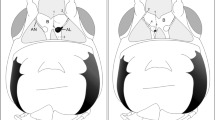Summary
We have traced the central projections of the receptor neurons associated with each of the eleven “largest” taste hairs on the labellum of the blowfly, Phormia regina (Meigen), by staining them with cobaltous lysine. The eleven hairs fall into three groups which reflect their peripheral locations and their branching patterns in the subesophageal ganglion. Group 1, consisting of the anterior hairs (numbers 1 and 2) and Group 3, consisting of the posterior hairs (numbers 9–11) project bilaterally, while Group 2, consisting of the middle hairs (numbers 3–8) projects primarily ipsilaterally. The central projections of the hairs within a single group are similar. Each hair houses four chemoreceptors, which have differing chemical sensitivities and behavioral roles, and one mechanoreceptor. In some cases, there were indications that the different cells within a single hair have different central branching patterns. For some hairs, however, it was clear that a single central branching region and pattern was shared by more than one receptor cell. We failed to find either a continuous somatotopic representation of a hair's position on the periphery, or an anatomical segregation of receptors coding for different modalities. Behavioral experiments indicate that the fly is informed both of the identity of the hair stimulated and of the chemical nature of the stimulus. Our results suggest that this information is not represented on a gross anatomical level.
Similar content being viewed by others
References
Bacon JP, Altman JS (1977) A silver intensification method for cobalt-filled neurones in wholemount preparations. Brain Res 138:359–363
Bacon JP, Murphey RK (1984) Receptive fields of cricket giant interneurones are related to their dendritic structure. J Physiol 352:601–623
Daley DL (1982) Neural basis of wind-receptive fields of cockroach giant interneurons. Brain Res 238:211–216
Dethier VG (1976) The hungry fly. Harvard University Press Cambridge, Massachusetts
Falk R, Bleiser-Avivi N, Atidia J (1976) Labellar taste organs of Drosophila melanogaster. J Morphol 150:327–342
Ghysen A (1980) The projection of sensory neurons in the central nervous system of Drosophila: Choice of the appropriate pathway. Develop Biol 78:521–541
Jacobson M (1978) Developmental neurobiology. Plenum Press, New York, pp 345–433
Levine RB, Pak C, Linn D (1985) The structure and metamorphic reorganization of somatotopically projecting sensory neurons in Manduca sexta larvae. J Comp Physiol 157:1–13
Murphey RK, Jacklet A, Schuster L (1980) A topographic map of sensory cell terminal arborizations in the cricket CNS: Correlation with birthday and position in a sensory array. J Comp Neurol 191:53–64
Nayak SV, Singh RN (1985) Primary sensory projections from the labella to the brain of Drosophila melanogaster Meigen (Diptera: Drosophilidae). Int J Insect Morphol Embryol 14:115–129
Normann TC, Duve H (1969) Experimentally induced release of a neurohormone influencing hemolymph trehalose level in Calliphora ervthrocephala (Diptera). Gen Comp Endocrinol 12:449–459
Peters W, Richter S (1965) Morphological investigations on the sense organs of the labella of the blowfly, Calliphora ervthrocephala Mg. Proc XVI Int Congr Zool Washington 3:89–92
Romer H (1983) Tonotopic organization of the auditory neuropile in the bushcricket Tettigonia viridissima. Nature 306:60–62
Springer AD, Prokosch JH (1982) Surgical and intensification procedures for defining visual pathways with cobaltous-lysine. J Histochem Cytochem 30:1235–1242
Spurr AR (1969) A low-viscosity epoxy embedding medium for electron microscopy. J Ultrastruct Res 26:31–43
Stocker RF, Schorderet M (1981) Cobalt filling of sensory projections from internal and external mouthparts in Drosophila. Cell Tissue Res 216:513–523
Strausfeld NJ, Nässel DR (1981) Neuroarchitectures serving compound eyes of Crustacea and insects. In: Autrum H (ed) Vision in invertebrates. Springer, Berlin Heidelberg New York (Handbook of sensory physiology, vol VII/6b) pp 1–132
Wilczek M (1967) The distribution and neuroanatomy of the labellar sense organs of the blowfly Phormia regina Meigen. J Morphol 122:175–201
Wolk FM van der, Koerten HK, van der Starre H (1984) The external morphology of contact-chemoreceptive hairs of flies and the motility of the tips of these hairs. J Morphol 180:37–54
Yetman S, Pollack GS (1985) Proboscis extension in the blowfly: positional effects of chemoreceptors. Soc Neurosci Abst 11:1219
Author information
Authors and Affiliations
Rights and permissions
About this article
Cite this article
Yetman, S., Pollack, G.S. Central projections of labellar taste hairs in the blowfly, Phormia regina Meigen. Cell Tissue Res. 245, 555–561 (1986). https://doi.org/10.1007/BF00218557
Accepted:
Issue Date:
DOI: https://doi.org/10.1007/BF00218557




